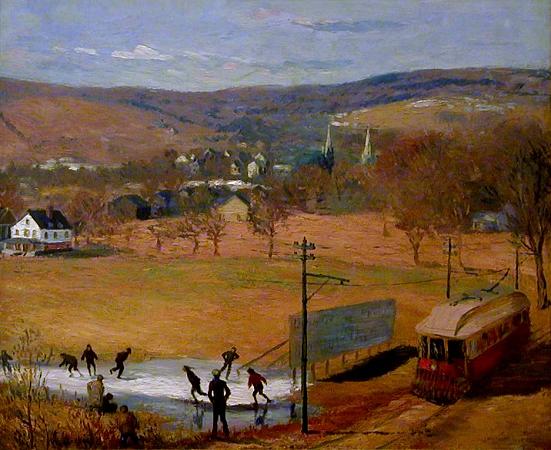William Glackens (1870 - 1938). William James Glackens was an American realist painter and one of the founders of the Ashcan School of American art. He is also known for his work in helping Albert C. Barnes to acquire the European paintings that form the nucleus of the famed Barnes Foundation in Philadelphia. His dark-hued, vibrantly painted street scenes and depictions of daily life in pre-WW I New York and Paris first established his reputation as a major artist. His later work was brighter in tone and showed the strong influence of Renoir. During much of his career as a painter, Glackens also worked as an illustrator for newspapers and magazines in Philadelphia and New York City. Glackens was born in Philadelphia, Pennsylvania, where his family had lived for many generations. William had two siblings: an older sister, Ada, and an older brother, cartoonist and illustrator Louis Glackens. He graduated from the prestigious Central High School in 1890. Throughout his school years, he showed a great interest in and aptitude for drawing and drafting. After graduation, Glackens became an artist-reporter for The Philadelphia Record. In 1892, he left that newspaper and began illustrating for the Philadelphia Press. He enrolled in evening classes at the Pennsylvania Academy of the Fine Arts, studying under the renowned realist Thomas Anshutz. Glackens was not a steady pupil, as art critic Forbes Watson would observe in 1923: So much impression did the various instructors make upon him that today he can hardly remember who taught there when he was a pupil. John Sloan also attended the Academy, and he introduced Glackens to Robert Henri, a talented painter and charismatic figure in Philadelphia art circles. Henri played host to regular artists' gatherings at his studio, occasions to socialize, drink, sketch, talk about art, and give artistic criticism of one another's work. Henri urged the young men he brought together to read Whitman and Emerson, William Morris Hunt's Talks on Art and George Moore's Modern Painting, and to think about the need to create a vigorous new American art that spoke to their time and experience. These gatherings were the inspirational beginning of what became known as the Ashcan school of American art, a style that rejected the formality and gentility of 19th-century academic art and looked to working-class and middle-class metropolitan life for its material. In 1895, Glackens traveled to Europe with several fellow painters, including Henri, to paint and to immerse himself in European art. He first visited Holland where he studied the Dutch masters. He then moved to Paris, where he rented a studio for a year with Henri and enjoyed his first exposure to the art of the Impressionists and Post-Impressionists. Such a trip was common for artists of the time who wished to establish themselves in an American art world still looked upon as provincial by those artists and art lovers with a deeper experience of the Old Masters and the new art movements. While in Paris, Glackens painted independently, but did not attend any classes. Later in life, a confirmed Francophile, Glackens returned periodically to paint in Paris and the south of France. Upon settling in New York in 1896, Glackens began work as an artist for the New York World, a position he attained through his friend and fellow illustrator George Luks, a painter who had also been a participant in the Henri studio sessions in Philadelphia. Glackens later became a sketch artist for the New York Herald. He also worked as an illustrator for various magazines, including McClure's Magazine, which sent him to Cuba to cover the Spanish-American War. At this time, Glackens was making a living as a magazine illustrator, but his real passion lay in painting. In 1901, he exhibited at the Allen Gallery with Henri and Sloan and thereafter gained favorable notice as an up-and-coming artist. In 1904, Glackens married Edith Dimock, the daughter of a wealthy Connecticut family. She was also an artist, and they lived together in a Greenwich Village townhouse, where they raised two children, Lenna and Ira. If many of their artist friends lived a bohemian life by the standards of the day, such was not the case with William and Edith Glackens. In 1957, Ira Glackens published an anecdotal book about his father and the role he played in the emerging realist movement in art. In 1906 he was elected into the National Academy of Design as an Associate member, and became a full Academician in 1933. In New York, Glackens became associated with a group of artists known today as The Eight, five of whom are considered Ashcan realists. The other members of this loose association were Arthur B. Davies, Ernest Lawson, and Maurice Prendergast.
more...













